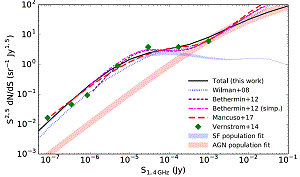- Details
- Published on 12 June 2018
Vol. 614
In section 4. Extragalactic astronomy
Constraints on submicrojansky radio number counts based on evolving VLA-COSMOS luminosity functions
 Radio emission in galaxies at frequencies below 30 GHz is mostly synchrotron radiation from cosmic electrons gyrating in magnetic fields. The electrons are accelerated by supernovae in star forming (SF) galaxies, and by an accreting supermassive black hole (SMBH) in active galactic nuclei (AGN). Comparison with other wavelengths, such as optical, IR, or X-ray, is necessary to disentangle the two possibilities. This paper presents the results of the Large Program COSMOS-3GHz with the VLA.
The total radio luminosity function (LF) since z~5.7 has been derived for the radio selected sample of 7826 galaxies with robust optical/near-infrared (NIR) counterparts. The populations of SF galaxies and AGN are separated on the basis of presence or absence of a radio excess with respect to the star-formation rates (SFRs) derived from the infrared (IR) emission. The redshift dependent pure luminosity evolution (PLE) model fitted to the data with an MCMC algorithm is in very good agreement with the previously published VLA-COSMOS LFs.
Different models of evolving LFs are able to reproduce the observed radio sky brightness, despite relying on extrapolations toward the faint end. The results imply that no new radio emitting galaxy population is present below 1 microJy. Selecting galaxies with radio flux densities between 0.1 and 10 microJy will yield a starforming galaxy in 90-95% of the cases with a large percentage of these galaxies existing around a redshift of z ~ 2, thus providing useful constraints for planned surveys with the Square Kilometer Array (SKA) and its precursors.
Radio emission in galaxies at frequencies below 30 GHz is mostly synchrotron radiation from cosmic electrons gyrating in magnetic fields. The electrons are accelerated by supernovae in star forming (SF) galaxies, and by an accreting supermassive black hole (SMBH) in active galactic nuclei (AGN). Comparison with other wavelengths, such as optical, IR, or X-ray, is necessary to disentangle the two possibilities. This paper presents the results of the Large Program COSMOS-3GHz with the VLA.
The total radio luminosity function (LF) since z~5.7 has been derived for the radio selected sample of 7826 galaxies with robust optical/near-infrared (NIR) counterparts. The populations of SF galaxies and AGN are separated on the basis of presence or absence of a radio excess with respect to the star-formation rates (SFRs) derived from the infrared (IR) emission. The redshift dependent pure luminosity evolution (PLE) model fitted to the data with an MCMC algorithm is in very good agreement with the previously published VLA-COSMOS LFs.
Different models of evolving LFs are able to reproduce the observed radio sky brightness, despite relying on extrapolations toward the faint end. The results imply that no new radio emitting galaxy population is present below 1 microJy. Selecting galaxies with radio flux densities between 0.1 and 10 microJy will yield a starforming galaxy in 90-95% of the cases with a large percentage of these galaxies existing around a redshift of z ~ 2, thus providing useful constraints for planned surveys with the Square Kilometer Array (SKA) and its precursors.


